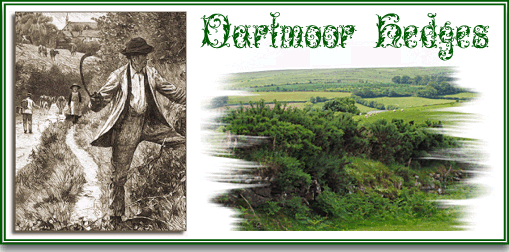
It is noticeable on Dartmoor how if one leaves the high moor how the field boundaries change from stone wall to bank or faced hedges which are typical of Devon. The main reason for this being that on the high moor there was an abundance of granite with which to built field or newtake walls whereas on the lower fringes there was less available stone. Another factor that was in favour of the bank hedge was that due to the lack of woodland the hedge trees provided a source of wood for poles, faggots, and bark. The bank hedge would also provide an efficient windbreak for crops and livestock, in addition the hedge would also control soil erosion and run-off during the wet, winter months. The bank hedge was built by firstly digging a trench, the soil from which would be piled up on the owners side of the land into a mound of about 4 – 6ft high and 4ft wide. On top of this would be planted oak, ash, birch or hazel trees which as they grew would be coppiced and after 15 – 20 years of growth would provide wood for many purposes.
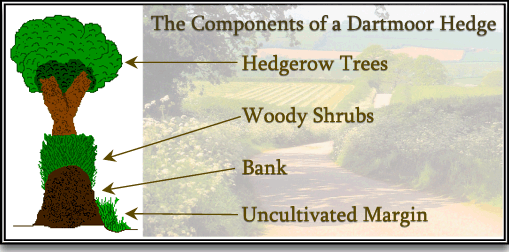
Not only would the trees provide an excellent source of wood the trees, shrubs and grass roots would also help hold the bank together thus making it stronger. Below is a photograph of two established hedgerows that flank a moorland lane. Note how the canopy has almost interwoven down the lane and the effect of neglecting coppicing and letting the trunks grow too large.
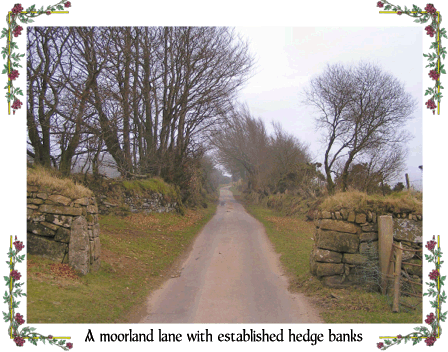
Having built the hedge it had to be maintained to keep it stock-proof and tidy which meant fraithing, steeping, and gapping. Fraithing was when cut branches were weaved through growing vegetation in order to strengthen the hedge. Steeping was considered a skilled job and involved cutting partially through the slender trunks of growing trees, these would then be bent down and over to form a layered, living, and stock-proof hedge, an example is show in the picture below:
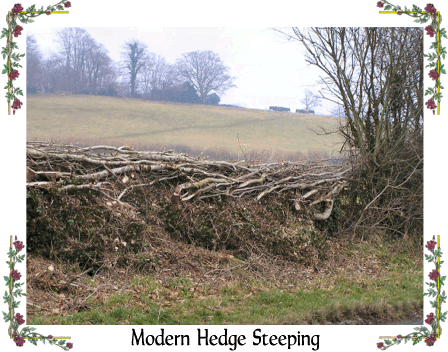
Gapping was simply repairing the hedge banks to ensure they remained in a secure and neat state by removing any excess of brambles etc. Most hedgework was done after the corn harvest had been gathered and before the onset of winter. When cutting brambles the hedger would wear a pair of wide leather cuffs which would be toed onto the bramble hook between the blade and handle. These were called mops and they would protect the hedger from the vicious bramble thorns. As the hedges were cut for poles and faggots to be used on the farm, any surplus would be sorted and bound and then the faggots sold, in 1903 they were fetching 1½d each, this would equate out to about 41p in today’s money. Although not on Dartmoor, Vancouver in 1808 describes the operation of enclosing 200 acres with a bank hedge:
“Rising a mound on a nine foot base, with a ditch three feet wide on each side, facing the mound four feet high with stones, sodding three feet higher above the stonework and leaving it four and a half feet broad at the top… Collecting and planting two rows of oak, ash, beech, hazel, and hawthorn at eighteen inch intervals. (These shrubs were collected from waste hedgerows and nearby woods.) Wattling – the collection, preparation and planting of quick growing willow shoots along the outer edge of the bank which protected the hedge shrubs from stock and weather… Total cost 15 shillings per perch (5½ yards).“
In some cases the hedges would form part of parish or estate boundaries thus indicating their age. The glebe terrier of 1613 for the parish of Meavy describes the parish boundary as going, “directly downwards by a hedge til it comes to a bounde in the hie Waie at lake…” There is a theory for hedge-dating known as the ‘Hooper Rule,’ which suggests that in every 300ft or in some cases 30 metres of hedgerow each individual shrub species growing in it represents 100 years. Or in other words, a hedge will gain a new species of shrub every hundred years. So, for example, if a three hundred foot section of hedgerow contained hawthorn, holly and spindle it can be assumed that it is about 300 years old. This is a dangerous theory to use as Muir, 2005, pp.88-92, points out,
“Where is the mechanism that opens a hedgerow or colonist of a new species just once every century? Who or what is there to prevent two, three or more species getting in during a particular century.“
A hedgerow survey carried out in 1841 revealed that in the county of Devon there was 1,651 miles of hedgerow, which to put that into perspective is half as long again as the Great Wall of China.
The other type of hedge found on Dartmoor is the stone faced hedge. This type is unique to the West Country and there have been various suggestions as to why. These include providing a stock shelter from the severe winds, prevention of soil erosion, a way of raising the hedge shrubs above wet land, and as walls for rabbit warrens. These hedges are built by first digging a ditch and then building a ‘hollow wall’ backfilling it with the soil and compacting it down as the wall heightens. Once the hedge has reached the required height it is capped with a crown. The crown was then planted with shrubs and trees which served as the same as the bank hedge. The hedge is normally between 4 and 6 feet high with a concavity of 3 – 4 inches. In some cases the stones were then faced with turves which would help protect the stone face and add extra stability once they had grown in.
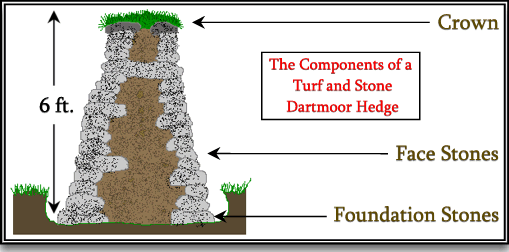
Below is an example of a modern restoration of an old stone faced hedge bank, note the established trees standing on top of the bank of the older section towards the back of the photograph.

It may seem strange to fence such a hedge with barbed wire but this is to stop the moor cattle and ponies browsing on the vegetation of the crown of the wall before it can become established.
The other important aspect of the hedges is the habitat they provide for a diverse range of flora and fauna. They also provide a ‘safe corridor’ for the various small mammals to move from field to field and protect them from predation as well has providing a secure home for many of them. Conversely they also provide a hunting ground for the smaller predators such a weasels, stoats and even adders.
 Legendary Dartmoor The many aspects past and present of Dartmoor
Legendary Dartmoor The many aspects past and present of Dartmoor
